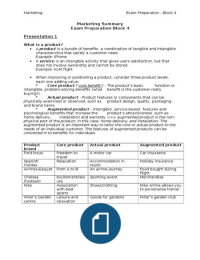Marketing Exam Preparation - Block 4
Marketing Summary
Exam Preparation Block 4
Presentation 1
What is a product?
A product is a bundle of benefits: a combination of tangible and intangible
characterictics that satisfy a customer need.
Example: iPhone
A service is an intangible activity that gives users satisfaction, but that
does not involve ownership and cannot be stored.
Example: KLM flight
When improving or positioning a product, consider three product levels,
each one adding value:
* Core product (‘core benefit’) - The product’s basic function or
intangible, problem-solving benefits (what benefit is the customer really
buying?)
* Actual product - Product features or components that can be
physically examined or observed, such as product design, quality, packaging
and brand name
* Augmented product - Intangible, service-based features and
psychological benefits that increase the product’s attractiveness, such as
home delivery, installation and warranty >>> augmented product is the non-
physical part of the product; in this case: home delivery, and installation. The
augmented product is an important way to tailor the core or actual product to the
needs of an individual customer. The features of augmented products can be
converted in to benefits for individuals.
Product Core product Actual product Augmented product
brand
Ford focus Freedom to A motor car Car insurance
travel
Spanish Relaxation Accommodation in Holiday insurance
Holiday resort
Airlines-Easyjet From A to B An airline journey Food bought during
flight
Chelsea Excitement/leis Sporting event Merchandise
(football) ure
Nike Association Shoes/clothing Nike online allows you
with best to personalise trainer
sports
Hiller’s Garden Leisure and Goods for gardens Hiller’s garden club
centre relaxation
,Marketing Exam Preparation - Block 4
Consumer goods classification (Copeland)
Based on consumer shopping habits, there are four categories of consumer
goods:
* Convenience products
- Frequently bought
- Minimum of shopping effort
- Low price
- Widely available
- Examples: Candy, bread
* Shopping products
- Less frequently purchased
- Compared on quality, price and style
- Relatively high price
- Selective distribution
- Examples: clothing, appliances
* Specialty products
- Buyer makes special purchasing effort
- High involvement
- Strong brand preference
- Limited distribution
- Examples: perfume, cars
* Unsought goods
- Unwanted or unknown products
- Potential buyers are not motivated
- Require persuasive advertising and personal- selling
support
- Low purchase frequency
- Examples: life insurance, donor card
Product life cycle: the stages that a product passes through over time in
the marketplace (graphically depicted)
PLC stages and related marketing objectives:
* Introduction: Market penetration
* Rapid growth: Create brand preference
* (Turbulence:) Maintain brand loyalty
* Maturity: Defend market share
>>> If certain products, like LED TV’s, go into the maturity phase, many
companies try to stretch out the life of a product through a series of sequential
measures. This strategy is known as market stretching.
, Marketing Exam Preparation - Block 4
* Decline: Milk the product
>>> If certain products, like LCD TV’s, go into the decline phase and enough
competitors will leave the market so that a firm - although it may pull of
unattractive market segments - can profitably continue to serve those customers
who still want the product. This is known as retrenchment strategy.
Adopter categories
Five groups of buyers, based on how long it takes them to adopt a new
product:
* Innovators
* Early adopters
* Early majority
* Late majority
* Laggards
The product mix is the total assortment of products and services that the
company sells, including various product lines, products, product types and
brands.
A product line is a group of closely related items in the organisation’s
assortment or product mix.
E.g. soft drinks are a product line that includes products such as cola and fruit
juice. Fruit juice is a product that includes product types (or product items) such
as apple juice and grape juice.
Width of the assortment refers to the number of product lines that a company
sells > can me narrow (specialty stores) or wide (department stores).
Length of the assortment refers to the total number of articles that a company
offers.
Depth of the assortment refers to the number of product items in a product
line.
Height of the assortment refers to product mix consistency if the products fall
within the same price range.
Trading up or an up-market stretch is lengthening the product line with a
higher prices, better quality product to meet the needs of the high end of the
market.
Trading down or down-market stretch is lengthening the product line beyond
its current range to tap a new, price sensitive segment at the lower end of the
market.
> For both product assortment strategies you have to be aware of the effects on
your brand name etc.
When a new product has been well received by the target market, the company
may launch other products or product items under the same brand name,
possibly in new market segments. This is known as brand stretching.
Line extension is if the company uses the existing brand name for new product
items in the same product line. However, brand extension is a completely
different strategy, since the existing, well established brand name is now applied
to a new product in a different product class or category.
To enable excellent and efficient service delivery, many companies develop
vertical marketing systems at different levels in the supply chain, working
together with other organisations in a professionally managed and centrally
coordinated network with an agreement on customer service task responsibilities.





